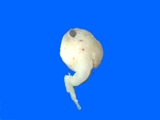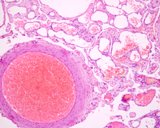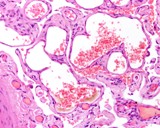This page is part of the site called Surgical Pathology of the
Canine Male Reproductive Tract by
A varix or varices of this area is called a varicocele. It can be a
small structure comprised of dilated veins, but usually those that are
clinicaly identified are large and thrombosed. Varicocele is common
in humans as the left testicular vein terminates at the left renal vein,
and the insertion site causes increased pressure in this location. Spontaneous
cases of primary varicocele in dogs are not reported, but dogs are used
as an experimental model for varicocele in man. Increasing pressure
in the spermatic vein has been done by surgical ligation.
There are two cases in the YB database (YB20491, 45435) where histologically
there were dilated thrombosed veins in the pampiniform plexus. Examination
of the formalin fixed tissues of one case confirmed this as a varicocele.
There was necrosis and fibrosis in the tissues suggesting trauma. No
other evidence of torsion was seen, so injury to the vessels, fibrosis
and an increased venous pressure was thought to be the pathogenesis.
The cause of the second case is not known.
Secondary varicocele formation is reported. McNeil and Weaver (1980)
reports varicosities developing secondary to metastatis of Sertoli cell
tumors.
McNeil PE, Weaver AD. (1980) Massive scrotal swelling in two unusual
cases of canine Sertoli cell tumour. Vet Rec 106: 144-146.
Turner TT. (2001) The study of varicocele through the use of animal
models. Hum Reprod Update. 7(1):78-84.
Inflammation of the spermatic cord is called funisitis or funiculitis.
Inflammation of the cord is unusual. It has been reported in Brucella
canis infection (Brennan et al 2008). Complications of castration
with contamination of the spermatic cord with bacteria or foreign material
is unusual with the appropriate surgical procedures.
Vasculitis
Vascultitis of the vessels is reported and seen occasionally. It is
reported in beagles with systemic vascilitis (canine juvenile polyarteritis
syndrome (beagle pain syndrome).) (Albassam et al 1989) and periodically
in other animals. Primary signs are unusual, but ischemic changes in
the testis incuding degeneration occur. No gross lesions are reported
to the spermatic cord, but histological changes can be dramatic.
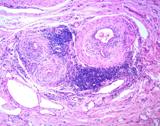
Figure : Vasculitis of the testicular artery (YB144756)
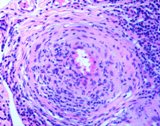
Figure : Arteritis of testicular artery
Fibrosis of the spermatic cord was an unusual finding in one dog (YB116854).
This lesion is likely to be the end result of vasculitis.
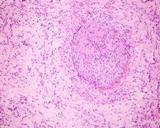
Figure :Fibrosis of spermatic cord and vascular hypertrophy/fibrosis
(YB116854)
Albassam MA, Houston BJ, Greaves P, Barsoum N. (1989) Polyarteritis in
a beagle. J Am Vet Med Assoc. 194(11):1595-1597.
Brennan SJ, Ngeleka M, Philibert HM, Forbes LB, and Allen AL (2008) Canine
brucellosis in a Saskatchewan kennel. Can Vet J. 49(7): 703-708.



